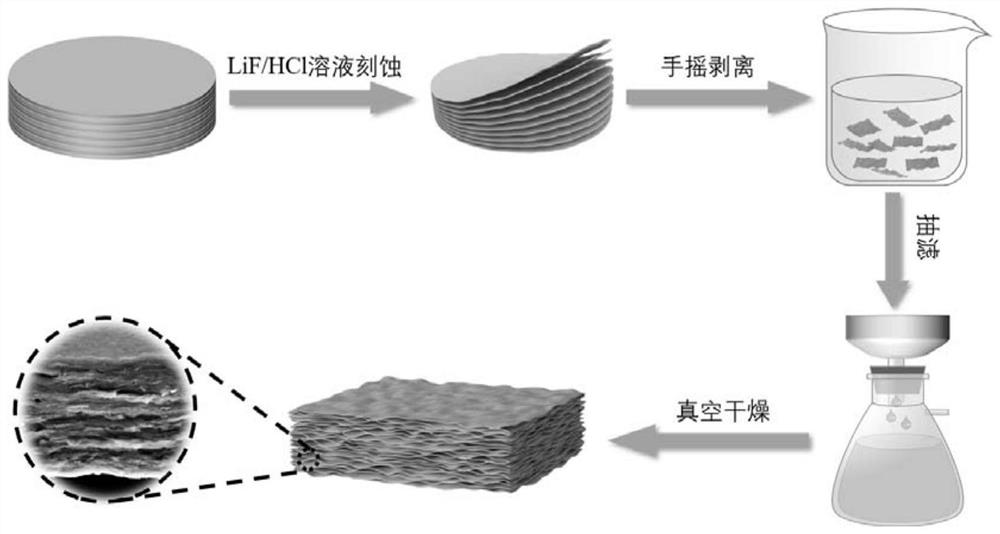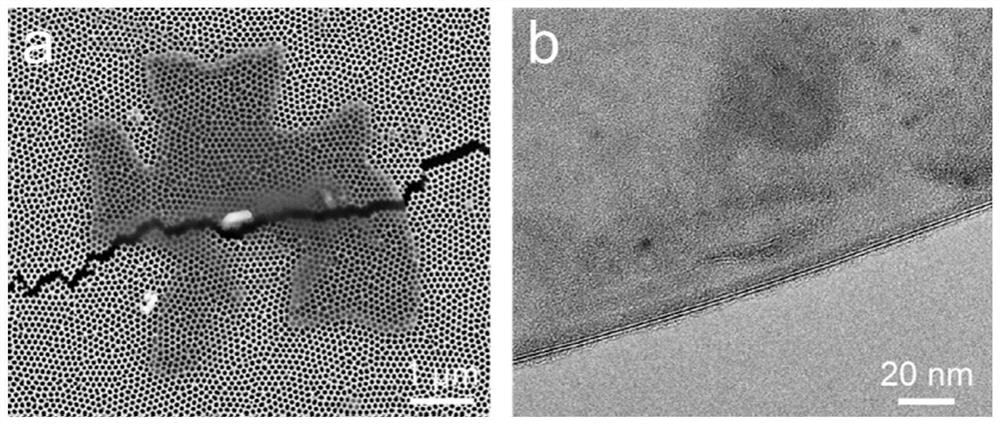Preparation method and application of SERS film substrate based on MXene
A substrate and thin film technology, applied in chemical instruments and methods, nanotechnology for sensing, inorganic chemistry, etc., can solve problems such as unsatisfactory Raman enhancement effect, achieve excellent SERS enhancement effect, large monolithic area, Simple preparation process
- Summary
- Abstract
- Description
- Claims
- Application Information
AI Technical Summary
Problems solved by technology
Method used
Image
Examples
Embodiment 1
[0065] The preparation method of self-supporting layered material TiVC is as follows:
[0066] (1) Take 30mL of hydrochloric acid with a concentration of 9M and put it in a polytetrafluoroethylene beaker, weigh 2.8g of LiF powder and dissolve it in the hydrochloric acid solution, and stir magnetically at 20-30°C for 10min to completely dissolve the LiF powder. Weigh 2g of TiAlVC powder and slowly add it to the mixed solution of lithium fluoride-dilute hydrochloric acid at a rate of 1g / 10min, cover with a layer of plastic wrap, and stir magnetically at 20-30°C for 10min. The beaker was transferred to a water bath at a constant temperature of 35°C, and the reaction was carried out for 72 hours under magnetic stirring. After the reaction is over, transfer the resulting sol-like liquid to a centrifuge tube, add deionized water, and centrifuge at 3500rpm / min to wash thoroughly, take the precipitate, repeat several times, each time for 5min, until the supernatant after centrifugatio...
Embodiment 2
[0070] In this embodiment, compared with embodiment 1, the difference is:
[0071] In step (1), the reaction system was placed in a water bath at a constant temperature of 40° C. to react, and finally a self-supporting TiVC film SERS substrate was obtained.
[0072] Take 5 μL of the ethanol solution of R6G with a concentration of 1 mM and drop it on the surface of the SERS substrate prepared in Example 2. After it dries naturally, put it under a micro Raman spectrometer for detection.
[0073] Such as figure 2 As shown in a, the SEM photo of the two-dimensional TiVC nanosheets prepared in Example 2 on porous alumina, the TiVC nanosheets are highly transparent under electron beam irradiation; figure 2 b is the TEM photo of the prepared few-layer TiVC nanosheets. It can be seen that the obtained two-dimensional TiVC nanosheets have two layers, indicating that the prepared two-dimensional material TiVC is a thin-layer nanosheet.
[0074] Such as image 3 Shown is the SEM pho...
Embodiment 3
[0082] In this embodiment, compared with embodiment 1, the difference is:
[0083] In step (1), the reaction time is set to 84h, and finally a self-supporting film TiVC is obtained.
[0084] Such as Figure 10 Shown is the SEM photo of the self-supporting film TiVC described in Example 3.
[0085] Such as Figure 11 Shown is the Raman spectrum of the self-supporting film TiVC prepared in Example 3 used as the SERS substrate to detect different concentrations of R6G.
[0086] Such as Figure 12 As shown, we calculated the energy band and electronic density of states (DOS) of TiVC. The results show that: TiVC has obvious metal characteristics, and the conduction band is mainly composed of Ti 3d orbital and V 3d orbital, and V 3d orbital is in The contribution at the Fermi level is greater than that of Ti 3d orbitals, which further explains the excellent electronic conductivity of TiVC, which is conducive to the generation of strong surface plasmon resonance, which plays a ro...
PUM
 Login to View More
Login to View More Abstract
Description
Claims
Application Information
 Login to View More
Login to View More - R&D
- Intellectual Property
- Life Sciences
- Materials
- Tech Scout
- Unparalleled Data Quality
- Higher Quality Content
- 60% Fewer Hallucinations
Browse by: Latest US Patents, China's latest patents, Technical Efficacy Thesaurus, Application Domain, Technology Topic, Popular Technical Reports.
© 2025 PatSnap. All rights reserved.Legal|Privacy policy|Modern Slavery Act Transparency Statement|Sitemap|About US| Contact US: help@patsnap.com



